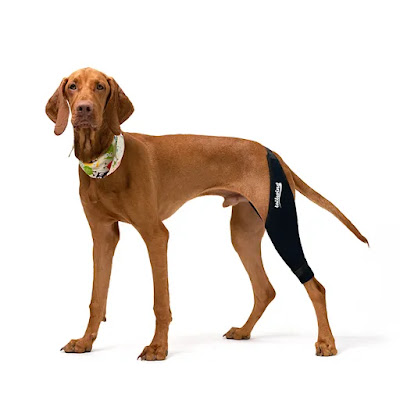Knee braces for dogs have become
increasingly popular in recent years as pet owners seek effective solutions to
improve their furry friends' comfort and mobility. Whether it's due to injury,
age-related conditions, or genetic predisposition, dogs can experience knee
problems that affect their quality of life. In this article, we will delve into
the details of how knee braces for dogs
work to enhance comfort and mobility, allowing our beloved companions to lead
happier, more active lives.
Common
Knee Problems in Dogs
Before
exploring the benefits of dog knee braces, it's essential to understand the knee problems commonly faced
by dogs. Some of the most prevalent knee conditions in canines include:
Cranial Cruciate Ligament
(CCL) Tears: Similar to
the anterior cruciate ligament (ACL) tears in humans, CCL tears are one of the
most frequent knee injuries in dogs. This injury can cause pain, instability,
and difficulty in walking or running.
Patellar Luxation: Patellar luxation refers to the dislocation
of the kneecap, which can result in lameness and reduced mobility.
Meniscal Tears: Meniscal tears often accompany CCL
injuries and can cause further pain and discomfort in the knee joint.
Arthritis: Arthritis, a degenerative joint disease,
commonly affects older dogs and can lead to joint stiffness, inflammation, and
reduced mobility.
The
Advantages of Knee Braces for Dogs
Dog knee braces are specially designed to provide
support, stability, and pain relief to dogs suffering from knee issues. Here
are the key advantages of using knee
braces for dogs:
Pain Management: Knee braces help alleviate pain and
discomfort associated with knee injuries or conditions. By reducing strain on
the affected area, they promote a more comfortable experience for your dog.
Stability and Support: A dog knee brace
offers external support to the knee joint, reducing instability and the risk of
further injury. It helps dogs regain confidence in their movements and prevents
excessive stress on the affected knee.
Increased Mobility: By providing stability and pain relief,
knee braces enable dogs to move more freely. They can walk, run, and play
without experiencing as much discomfort or difficulty.
Post-Surgical Recovery Aid: Knee braces play a vital role in
post-surgical recovery by protecting the knee joint and surgical site. They
help stabilize the knee during the healing process, preventing excessive
movement and promoting proper alignment.
Types
of Knee Braces for Dogs
There
are various types of knee braces available for dogs, each designed to address
specific needs. The two main types are:
Hinged Knee Braces: Hinged
dog knee braces feature built-in hinges that mimic the natural movement of
the knee joint. They provide excellent support and stability, making them
suitable for dogs with ligament injuries and instability.
Sleeve-Style Braces: Sleeve-style knee braces are made of
stretchable fabric and provide compression and support to the knee joint. They
are often used for dogs with mild knee issues or as a preventive measure to
reduce strain on the knee joint.
Ensuring
Proper Fit and Usage
To
ensure the effectiveness of a dog knee brace,
it is crucial to select the right size and fit for your dog. A poorly fitted
brace may not provide the necessary support and can potentially cause
discomfort. It is recommended to consult with your veterinarian or a
professional canine orthopedic specialist to determine the correct brace size
and fit for your dog's specific condition.
It
is important to note that knee braces
for dogs should be used as part of a comprehensive treatment plan under the
guidance of a veterinarian. They are not a substitute for professional care and
should only be used after a proper diagnosis.
Conclusion
Knee braces for dogs are
valuable tools in enhancing comfort and mobility for our furry companions. By
providing support, stability, and pain relief, these braces help dogs with knee
injuries or conditions regain their quality of life. Whether it's a torn CCL,
patellar luxation, meniscal tears, or arthritis, knee braces can make a
significant difference in a dog's ability to walk, run, and play. However, it
is crucial to consult with a veterinarian to ensure the proper diagnosis,
fitting, and usage of the dog knee brace
for your dog's specific needs. With the right care and support, dogs can enjoy
improved comfort and mobility, leading to a happier and more active lifestyle.





No comments:
Post a Comment